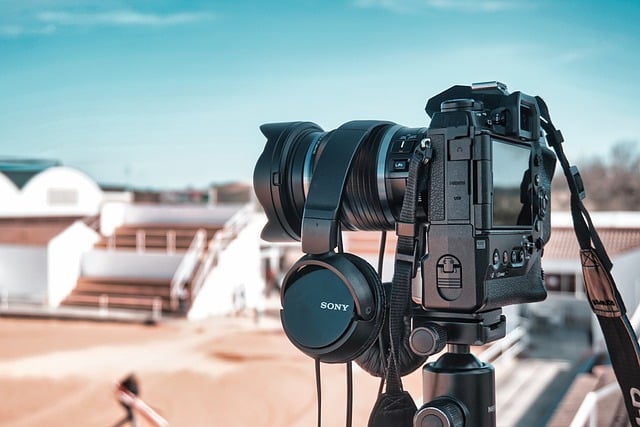Converting DivX to AVI preserves high-quality video and enhances compatibility. DivX, known for efficient compression, may not be supported by modern players. AVI format offers wide compatibility and maintains image quality even at low bitrates. Balancing image clarity and file size ensures smooth playback on diverse devices and platforms.
Discover the power of DivX and AVI formats: offering exceptional image quality even at low bitrates. This article explores how DivX’s efficient compression techniques allow for high-quality videos in smaller file sizes, ideal for streaming and storage. We’ll guide you through converting DivX to AVI, preserving visual fidelity step-by-step. Learn about real-world applications combining DivX’s efficiency with AVI’s versatility, ensuring optimal results for your video needs.
Understanding DivX and AVI Formats: A Brief Overview

DivX and AVI are two popular video formats known for their ability to offer high-quality video compression. DivX, introduced in 1995, was one of the first widely adopted formats for video encoding, offering efficient compression at the time. It uses a complex compression algorithm that reduces file sizes significantly while maintaining decent picture quality. AVI, short for Audio Video Interleave, is a container format developed by Microsoft in the early 1990s. It supports various codecs and is known for its versatility, making it compatible with numerous video players.
Converting DivX to AVI can be beneficial for several reasons. For instance, if you have an older video that was encoded in DivX and you want to ensure compatibility with modern devices or software, converting it to AVI might be a suitable choice. This process allows you to maintain the original quality while adapting the file format to meet contemporary playback needs.
– What is DivX?

DivX is a video codec—a software that compresses and decompresses video data—known for offering exceptional image quality at low bitrates. This makes it particularly useful for online streaming and video conversion, where file size needs to be minimized without compromising visual fidelity. One common use case for DivX involves converting DivX to AVI (Audio Video Interleave), a widely supported container format that maintains the original video and audio streams while offering better compatibility across various media players. This conversion process ensures that the high-quality output can be enjoyed seamlessly on different devices and platforms.
– Characteristics and usage of DivX.

DivX is a video codec known for offering exceptional image quality at low bitrates. This makes it particularly useful for compressing and converting videos without significant loss in visual fidelity. One common use case is converting DivX to AVI, which allows users to play back high-quality videos on various platforms and devices. DivX’s ability to maintain detail even at lower resolutions makes it a favorite among video editors and content creators looking to maximize file size efficiency while preserving visual quality.
The codec’s popularity stems from its efficient compression algorithms, which not only reduce file sizes but also enable smoother playback and reduced buffering times. This feature is especially valuable for streaming media and sharing videos online, where maintaining a balance between image quality and file size is paramount. By leveraging DivX, users can enjoy rich visual experiences without the usual trade-off between quality and file size.
– Introduction to AVI format and its advantages.

The AVI (Audio Video Interleave) format is a popular container for video and audio files, offering advantages such as compatibility across various platforms and devices. One of its key strengths lies in its ability to maintain exceptional image quality even at relatively low bitrates, making it an efficient choice for storing and sharing videos without significant loss of detail.
Converting DivX to AVI can be a straightforward process that leverages these benefits. DivX, known for its high-quality compression, can be seamlessly integrated into the AVI format, allowing users to enjoy crisp visuals and immersive audio in a widely supported container. This makes it ideal for online streaming, video editing, and sharing on social media platforms.
The Need for High-Quality at Low Bitrates

In today’s digital era, where multimedia content is ubiquitous, achieving exceptional image quality while maintaining efficient file sizes has become paramount. This need arises from various factors, including streaming, archival purposes, and mobile devices with limited storage. For instance, when converting DivX to AVI, users often seek the best possible output quality despite lower bitrates. The challenge lies in balancing detail preservation, compression artifacts, and file size, ensuring viewers still enjoy a rich visual experience without buffering or reduced performance.
High-quality video at low bitrates is essential for optimizing storage space, reducing bandwidth requirements, and facilitating seamless playback across diverse devices. It enables efficient distribution of content over limited network capacities, making it crucial for online streaming services, video sharing platforms, and mobile applications. Achieving this goal requires sophisticated compression techniques that intelligently reduce data redundancy while preserving critical visual elements, ensuring a vibrant and detailed image even at lower bitrates.
– Challenges in maintaining quality while reducing file size.

Maintaining exceptional image quality while reducing file size is a challenging balancing act. When converting formats, such as from DivX to AVI, the goal is to achieve a low bitrate that preserves visual clarity and minimal loss in detail. The difficulty lies in compressing video data effectively without sacrificing too much quality, especially in scenes with complex motion or intricate details.
Advanced codecs and compression algorithms play a crucial role in overcoming these challenges. They enable more efficient data reduction while preserving the overall aesthetic integrity of the content. By carefully selecting and optimizing these tools, it becomes possible to offer compact file sizes without noticeable degradation, ensuring viewers enjoy high-quality visuals even when bandwidth or storage is limited.
Converting DivX to AVI format offers a powerful solution for maintaining exceptional image quality while achieving lower bitrates. By understanding the unique characteristics and advantages of both formats, users can now optimize their video files for better streaming or storage efficiency without compromising visual fidelity. This conclusion highlights the practicality of this conversion method in today’s digital landscape, where high-quality content delivery is paramount.
